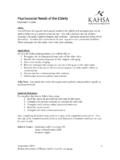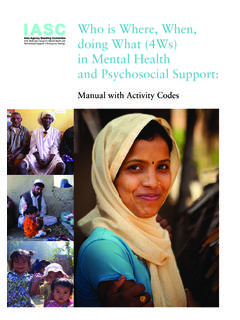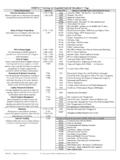Transcription of Erik Erikson’s Psycho-Social Stages of Development
1 Erik erikson s Psycho-Social Stages of Development erikson s eight Stages of psychosocial Development behaviors that may be associated with healthy and unhealthy expressions of the self s Development and ego boundary growth during erikson s first five Development and ego boundary growth during erikson s first five psychosocial Stages . Infancy Trust vs. Mistrust (1st year) If needs are met, infant develops a sense of basic trust Outward signs of Healthy Growth I. Expressions of Trust 1. invests in relationships 2. open, non-suspicious attitudes 3. lets mother go 4. welcomes touching 5. good eye contact 6. shares self and possessions Outward signs of Unhealthy Growth I. Expressions of Mistrust 1. avoids relationship 2. suspicious, closed, guarded 3. unwilling to let mother go 4. loner and unhappy 5. poor eye contact 6. does not share self or possessions Toddler Autonomy vs.
2 Shame and Doubt (2nd year) Toddler strives to learn independence and self-confidence II. Expressions of autonomy 1. independent 2. not easily led 3. resists being dominate 4. able to stand on own two feet 5. works well alone or with others 6. assertive when necessary II. Expressions of shame and doubt 1. procrastinates frequently 2. has trouble working alone 3. need structure and directions 4. has trouble making decisions 5. is easily influenced 6. Embarrassed when complimented Preschooler Initiative vs. Guilt (3-5 years) Preschooler learns to initiate tasks and grapples with self-control III. Expressions of initiative 1. is a self-starter 2. accepts challenges 3. assumes leadership roles 4. sets goals- goes after them 5. moves easily, freely with body III. Expressions of guilt 1.
3 Gets depressed easily 2. puts self down 3. slumped posture 4. poor eye contact 5. has low energy level Elementary School Competency vs. Inferiority (6 years to puberty) Child leans either to feel effective or inadequate IV. Expressions of industry 1. wonders how things work 2. finishes what starts 3. likes projects 4. enjoys learning 5. like to experiment IV. Expressions of inferiority 1. timid, somewhat withdrawn 2. overly obedient 3. procrastinates often 4. an observer, not a producer 5. questions own ability Adolescence Identity vs. Role Confusion (teen years) Teenager works at developing a sense of self by testing roles, then integrating them to form a single identity. V. Expressions of identity 1. certain about sex role identity 2. active interest in opposite sex V. Expressions of identity confusion 1. doubts about sex role identity 2. lacks confidence 3. plans for future 4.
4 Challenges adult authority 5. tends to be self-accepting 3. overly hostile to authority 4. overly obedient 5. tends to be self-rejection Young Adulthood Intimacy vs. Isolation (20-40 years) Young adult struggles to form close relationships and to gain capacity for intimate love. VI. Expressions of Intimacy 1. maintained friendship 2. physical and emotional intimacy 3. participation in games, groups 4. open, willing to interact 5. able to make and keep commitments VI. Expressions of Isolation and Self-Absorption 1. sabotage relationship 2. withdraws 3. avoidance, defensive 4. self defeating behavior 5. maintaining isolation 6. questions job performance Middle Adulthood Generativity vs. Stagnation (40-60 years) Middle-aged person seeks a sense of contributing to the world, through, for example family and work. VII. Expressions of Generativity 1. generativity 2. confident 3. productive work 4.
5 Their own person 5. willingness to invest in the next generation 6. achievement goals 7. willing to risk, explore, produce, take charge attitude. VII. Expressions of Stagnation 1. stagnation 2. watching 3. complaining, blaming 4. withdraws 5. obesity 6. fatalist attitude 7. dissatisfaction with self, job, life, mate 8. resentful Late Adulthood Integrity vs. Despair (65 years and up) Reflecting on life, the elderly person may experience satisfaction or a sense of failure. VIII. Expressions of Integrity 1. proud, content with self and life 2. still actively thinking about the future 3. healthy interaction with self 4. self approving 5. comfortable giving and sharing with others 6. likes being an example to others 7. accepts aging process gracefully and death as part of life cycle VIII. Expressions of Despair and Distrust 1. despair 2. deep resentment 3. nothing left, uselessness 4. low self esteem 5.
6 Anger at self, other, world, society 6. closed to others 7. complaints, irritable 8. anger at aging, feels cheated.







